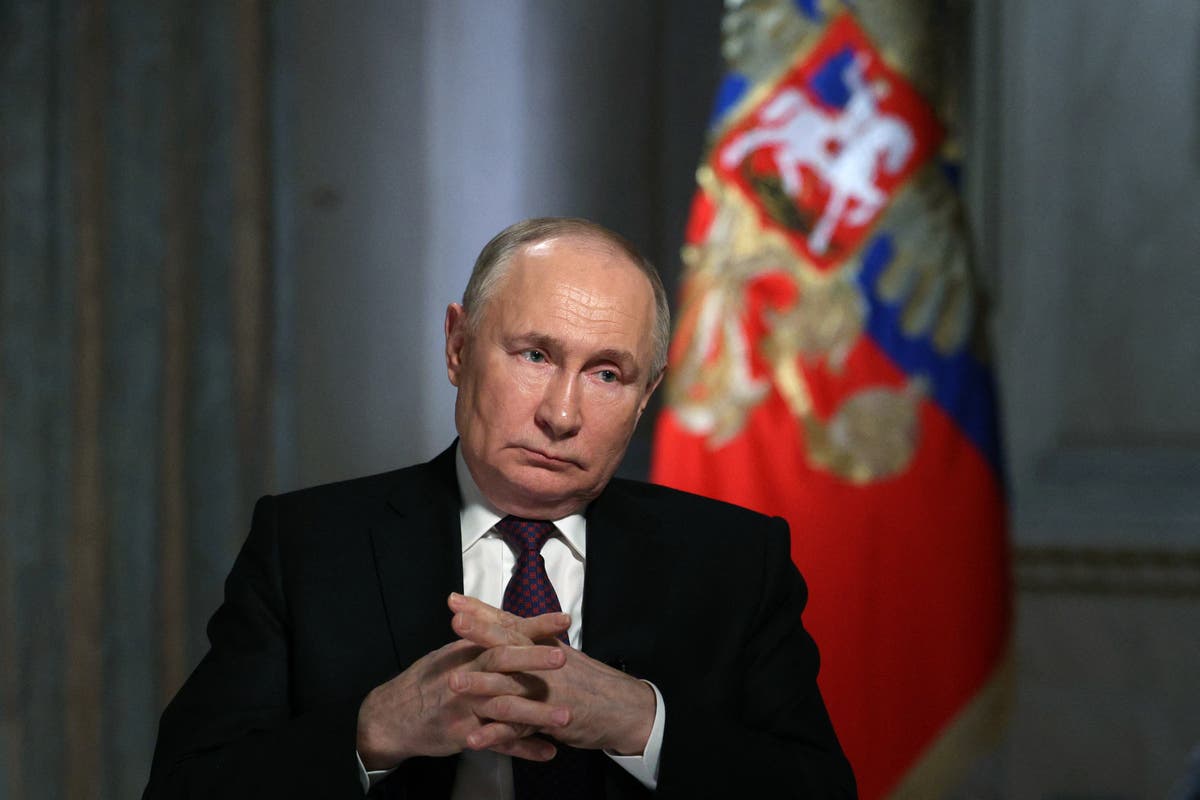
President Vladimir Putin has claimed Russia is ready to use nuclear weapons if there is a threat to statehood, sovereignty or independence.
In a rambling interview with Russian state television released early on Wednesday, Mr Putin also said he hoped the US would refrain from actions that could trigger a nuclear conflict.
His statement is another blunt warning to the West ahead of a presidential vote this week in which he is all but certain to win another six-year term. Mr Putin has consistently turned towards nuclear threats during Russia’s invasion of Ukraine, as Western allies have rallied around Kyiv.
Adrienne Watson, spokesperson for the White House National Security Council, said in a statement that “Russia’s nuclear rhetoric has been reckless and irresponsible throughout this conflict.”
“It is Russia that brutally invaded Ukraine without provocation or justification, and we will continue to support Ukraine as they defend their people and their sovereign territory from Russian aggression,” she added.
Mr Putin described US president Joe Biden as a veteran politician who fully understands the possible dangers of escalation. He said he does not think the world is heading to a nuclear war.
At the same time, he said Russia’s nuclear forces are in full readiness and “from the military-technical viewpoint, we’re prepared”.
Mr Putin said Moscow is ready to use nuclear weapons in case of a threat to “the existence of the Russian state, our sovereignty and independence”.
The most recent similar threat came in his state-of-the-nation address last month when he warned the West that deepening its involvement in the fighting in Ukraine would risk a nuclear war.
Ukrainian soldiers from The 56th Separate Motorized Infantry Mariupol Brigade prepare to fire a multiple launch rocket system based on a pickup truck towards Russian positions at the front line, near Bakhmut
But what are the key facts about Russia’s nuclear arsenal?
Russia, which inherited the Soviet Union’s nuclear weapons, has the world’s biggest store of nuclear warheads.
Putin controls about 5,580 nuclear warheads, according to the Federation of American Scientists (FAS).
Of those about 1,200 are retired but largely intact and around 4,380 are stockpiled for use by long-range strategic launchers and shorter-range tactical nuclear forces, according to the FAS.
Of the stockpiled warheads, 1,710 strategic warheads are deployed: about 870 on land-based ballistic missiles, about 640 on submarine-launched ballistic missiles, and possibly 200 at heavy bomber bases, FAS said.
In this pool photograph distributed by Russia’s state agency Sputnik, Putin gives an interview
Such numbers mean that Moscow could destroy the world many times over.
During the Cold War, the Soviet Union had a peak of around 40,000 nuclear warheads, while the US peak was around 30,000.
The United States said in its 2022 Nuclear Posture Review that Russia and China were expanding and modernising their nuclear forces, and that Washington would pursue an approach based on arms control to head off costly arms races.
“While Russia’s nuclear statements and threatening rhetoric are of great concern, Russia’s nuclear arsenal and operations have changed little since our 2023 estimates beyond the ongoing modernisation,” the FAS said in its 2024 analysis of Russian forces.
“In the future, however, the number of warheads assigned to Russian strategic forces may increase as single-warhead missiles are replaced with missiles equipped with multiple warheads,” FAS said.
Putin has said Russia would consider testing a nuclear weapon if the United States did.
Last year, he signed a law withdrawing Russia’s ratification of the Comprehensive Nuclear Test-Ban Treaty (CTBT).
Post-Soviet Russia has not carried out a nuclear test.
Joe Biden and Putin shake hands as they arrive for a US-Russia summit at Villa La Grange in Geneva in 2021
Since the Soviet Union collapsed in 1991, only a few countries have tested nuclear weapons, according to the Arms Control Association: the United States last tested in 1992, China and France in 1996, India and Pakistan in 1998, and North Korea in 2017.
The Soviet Union last tested in 1990.
The CTBT was signed by Russia in 1996 and ratified in 2000. The United States signed the treaty in 1996 but has not yet ratified it.
The Russian president is the ultimate decision maker on the use of the country’s nuclear weapons.
The so-called nuclear briefcase, or “Cheget” (named after Mount Cheget in the Caucasus Mountains), is with the president at all times. The Russian defence minister, currently Sergei Shoigu, and the chief of the general staff, currently Valery Gerasimov, are also thought to have such briefcases.
Essentially, the briefcase is a communication tool that links the president to his military top brass and thence to rocket forces via the highly secret “Kazbek” electronic command-and-control network. Kazbek supports another system known as “Kavkaz”.
If a nuclear attack were confirmed, Putin could activate the so-called ‘Dead Hand’
Footage shown by Russia’s Zvezda television channel in 2019 showed what it said was one of the briefcases with an array of buttons. In a section called “command” there are two buttons: a white “launch” button and a red “cancel” button. The briefcase is activated by a special flashcard, according to Zvezda.
If Russia thought it faced a strategic nuclear attack, the president, via the briefcases, would send a direct launch order to general staff command and reserve command units that hold nuclear codes. Such orders cascade swiftly down different communications systems to strategic rocket force units, which then fire at the US and Europe.
If a nuclear attack were confirmed, Putin could activate the so-called “Dead Hand” or “Perimeter” system of last resort: essentially computers would decide doomsday. A control rocket would order nuclear strikes from across Russia’s vast armoury.
The post The truth behind Putin’s rambling threats and Russia’s nuclear arsenal first appeared on The News And Times Review.


